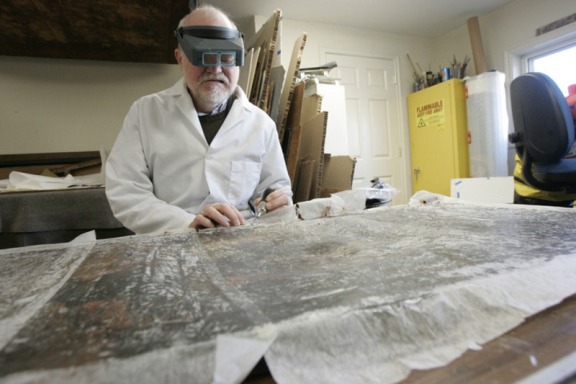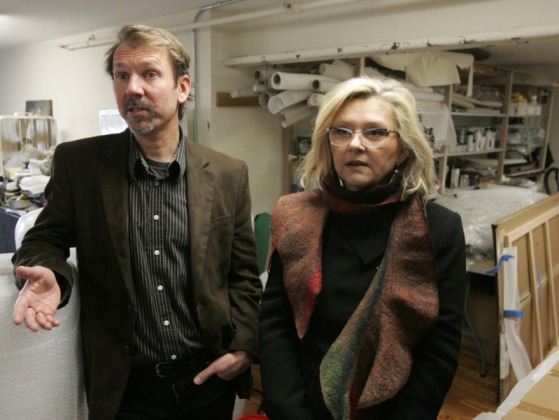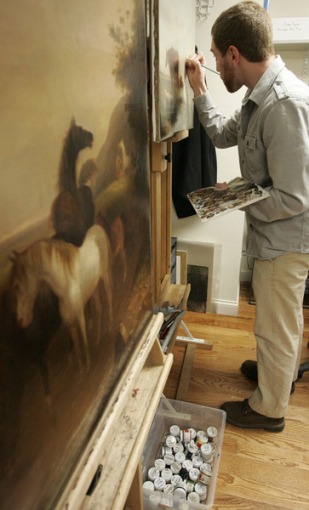

Restoration firm moves from Boston to Beverly
January 16, 2013
By Will Broaddus Staff writer
Oliver Brothers, the oldest art restoration firm in the country, has been making paintings beautiful again since 1850.
Over that time, the firm has taken in paintings by Rembrandt, Degas and Cezanne — as well as Andy Warhol, Andrew Wyeth and Winslow Homer — then returned them to their owners looking good as new.
Recently, the firm moved from Boston to Beverly.
“There are two main aspects to restoration: the structural aspect of the painting and the appearance of the painting,” said Peter Tysver, chief restorer at Oliver Brothers. “Both of these are usually compromised by age.”
Paintings dim with the years because their surfaces get dirty, or the coat of varnish that protects the paint deteriorates.

Peter Tysver, co-owner of Oliver Brothers Art Restoration in Beverly, removes the canvas from the stretchers of an early 19th-century screen

Greg Bishop, co-owner of Oliver Brothers Art Restoration in Beverly, and his wife, Mira, speak about the business.

Peter Brefini works on a painting by an unknown artist. The piece on the left is by Alvin Fisher
“The older varnishes were made with organic resins, which turn yellow over a period of time,” Tysver said. “So those are removed to get back to the original color.”
Structural damage occurs when canvas decays, or as the layers of a painting expand and contract with changes in the atmosphere. Those layers include sizing, a kind of glue that strengthens cloth and a coating of gesso, the white ground on which an artist paints.
“In the beginning, when the painting is new, the paint layer is flexible and there isn’t a problem,” Tysver said. “But when the paint layer gets older, it becomes brittle, and when the movement happens underneath the paint, it makes cracks.”
Many of these problems are fixed using a press that was invented by George Taylor Oliver, grandson of James Oliver, the Scottish immigrant who originally founded the firm in New York.
The pressure that smooths paint buckling around cracks, and also fixes a reinforcing liner to the back of the canvas, is created by suction.
“When it goes into the press, it gets sandwiched between these pieces of silicon-coated white craft paper,” said Greg Bishop, who co-owns Oliver Brothers with Tysver. “The vacuum sucks the air out, therefore forcing the adhesive”.
A version of this machine is now standard equipment at all art restoration firms, although that hasn’t benefited Oliver Brothers, because George Taylor never enforced his 1931 patent, Bishop said.
The firm’s original press was in operation until six years ago, when it was replaced with a new model, but they have kept the engine and plan to display it in their new lobby.
Moving to Beverly has doubled the company’s space, which in turn has allowed them to expand their business for customers who don’t need restoration work but would like a frame.
The quarters on Elliott Street feature display racks with frame styles from most major periods in art history, from the Italian Renaissance to the Hudson River School.
There are also frames made of unique materials, such as Peruvian leather, barn wood from Texas or pieces of buildings in New Orleans that were destroyed by Hurricane Katrina.
“It goes through a chemical process to kill any mold,” said Mira Bishop, Greg’s wife, who handles non-restoration custom framing for Oliver Brothers.
There has been sufficient demand for non-restoration framing that the firm now maintains two websites, www.oliverbrothersonline.com and www.oliverbrothersframes.com.
A frame that Bishop created from acrylic is also on display, and she applies her training as a designer to help clients “to see the artwork at its best.”
“I would very frequently go to a client’s home to match the colors, or say, ‘Could you email me photos of the room, so we could look at the whole picture,’” she said.
Moving to Beverly has made life easier for the co-owners, both of whom live on the North Shore, but also for their customers, who no longer have to look for parking in the Back Bay.
Another added benefit is the mixture of light available in the Beverly office, which offsets a perceptual problem called metamerism, in which complex colors look different in various types of light. Gray, for instance, may be a dull color, but it can be made with several mixtures — red and green, blue and orange — each of which looks different depending on the source of illumination.
In the new office, Tysver does retouching in an alcove where he gets light from both a large window and incandescent bulbs in the ceiling.
“The skill of the person that’s doing the retouching is to match the color paint,” Tysver said. “This balance of light here helps us get a middle range.”
Though people can now get degrees in restoration, the firm still trains workers in an apprentice system, which is how Tysver got his start, learning from previous owners Carroll Wales and Constantine Tsaousis.
Wales and Tsaousis, in turn, took over the firm from Fred Oliver, the last member of the founding family to work in the business, who taught them all the techniques the firm had developed over its history.
At any one time, Oliver Brothers has between 50 and 70 restoration jobs under contract, Bishop said, mostly from private clients rather than institutions.
Museums protect paintings by controlling temperature and humidity in their galleries and have in-house staff to address any damage that does occur.
While Oliver Brothers has worked on paintings by many great artists, the firm is just as likely to repair canvases whose only value is sentimental.
“It’s not just people thinking about investments, stocking paintings away for the future,” Bishop said. “In fact, a real important part is the sentiment behind it. People bring things in that they treasure personally.”